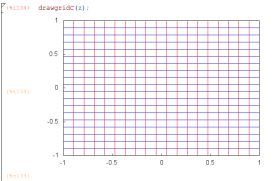For the thoroughly modern calculus student, an introduction to Complex Variables is all the more daunting because we don’t have the kind of geometric intuition-building machinery available to us for functions as we did for real-valued functions in calculus. Not that attempts haven’t been made…. In the coming weeks, I want to work on several techniques in Maxima. Here’s a first approach: conformal maps. The code drawgridC below is limited in its versatility, but couldn’t be simpler to call. Here are some examples,
/* plot the traces of complex valued function _f along grid lines in the square -1 <= Real(z) <= 1, -1<=Ima(z)<=1 blue - images of _f along horizontal lines red - images of _f along vertical lines */ drawgridC(_f):=block( [fx,fy,fxt,fyt,pl,j,ngrid], fx:realpart(rectform(subst(z=x+%i*y,_f))), fy:imagpart(rectform(subst(z=x+%i*y,_f))), pl:[], ngrid:19, for j:0 thru ngrid do( fxt:subst([x=-1+j*2/ngrid,y=t],fx), fyt:subst([x=-1+j*2/ngrid,y=t],fy), pl:cons([parametric(fxt,fyt,t,-1,1)] , pl) ), pl:cons([color=red],pl), for j:0 thru ngrid do( fxt:subst([y=-1+j*2/ngrid,x=t],fx), fyt:subst([y=-1+j*2/ngrid,x=t],fy), pl:cons([parametric(fxt,fyt,t,-1,1)] , pl) ), pl:cons([color=blue],pl), pl:cons([xlabel="",ylabel=""],pl), pl:cons([nticks=200],pl), apply(wxdraw2d,pl) );









